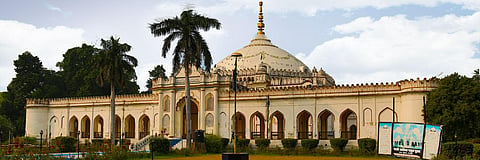Here's all you need to know about the lesser-known Shahnajaf Imambara in Lucknow
In Lucknow, the history and the charm of the royals has not been lost yet. The Nawabi Awadhs left a permanent mark on the city and some relics are being discovered even to this date. While the most famous places here happen to be the Bada and Chota Imambaras, there are a slew of these Imambaras littered all around the city.
Many of these Imambaras are still stuck in the past. What with all the modernization of Lucknow, these monuments have been forgotten and lost to the sands of time. Today, we give you an inside look at one of the most compelling Imambaras in town- Shahnajaf Imambara.
Take a walk down the mesmerising arches of Shahnajaf Imambara
To fully understand the importance of these Imambaras, it is a must to know exactly what an Imambara is and what it signifies. An "Imambara" or an "Imambargah" means (House of Imam or Court of Imam); this word is of North Indian origin. An Imambara is a place or a building with a hall where people assemble for "Majlis" (Mourning Congregations) of Imam Hussain and Martyrs of Karbala.
Shahnajaf Imambara is situated in the heart of the city. In fact, the entrance of the place is so unimpressive that you just may miss it from the main road. However, upon entering the gates, you are greeted by a formidable structure that has all the makings of an Awadhi influence.
Constructed by the last Nawab Wazir and the first King of the state of Awadh, Nawab Gazi-ud-Din Haider, in the years 1816-1817, the Shahnajaf Imambara signifies something more important that you may think. This imambara served as the King's mausoleum and was copy of Ali ibn Abi Talib's tomb in Najaf, Iraq.
For the uninitiated, Ali ibn Abi Talib is believed to be a cousin and son-in-law of the Islamic prophet Muhammad, which is why the place was made as grand and as royal as can be.
Shahnajaf Imambara is a place where time stops
Even today, within the gates of the Imambara, the grandeur and the royal touch of the place is not lost. Empty and staying, this place has a vibe that transcends the boundaries of time. Walking around the courtyard or the magnificently intricate arches of the corridors immediately puts you in an altered state of mind, away from the realities of Lucknow today.
Apart from that, the courtyard on the outside still carries an essence of what it was back in it's heyday- a place for people to come, sit together and bond with one another. Today, the yard is dotted with sportsmen, who essentially aim to do the same thing.
Knock Knock
Even today, as we pass the Imambara and catch a glimpse of it from our peripheral vision, it does beckon us, and invites us to come in and take a walk down the significantly historical lanes and arches of the structure. That being said, today, the Imambara stands dilapidated, forgotten and is one of the gems of Lucknow which is hidden in plain sight.
To get all the latest content, download our mobile application. Available for both iOS & Android devices.

